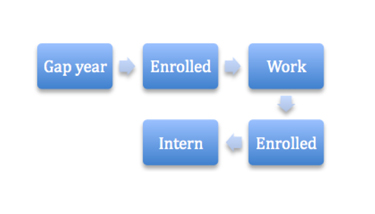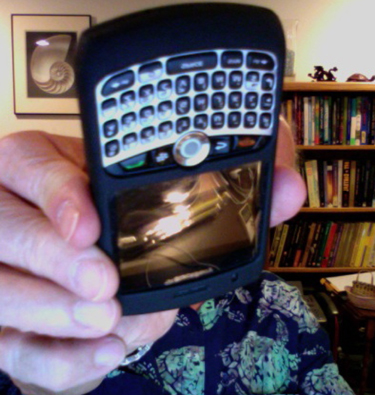Viewpoint
Swirling Students Need Semantic Search, Ontologies, Web Analytics, and More
Learning transactions are migrating from the classroom into the world. And students are increasingly designing a learning path (often the rationale for a particular path appears only retroactively) that includes a gap year between high school and college, includes two or more institutions toward the first degree, a semester abroad, internships and apprenticeships, field experience, service learning, part-time work or even time off for full-time work, and other forms of experiential learning. At one time, we had a clear distinction between formal learning and informal learning during the four undergraduate years, with informal learning being perhaps 80 percent of what a young person needed to know in life. That easy distinction has slipped away.
With such a revolution in learning, many issues arise. When I talk at conferences or on campuses, one question is bound to come up about trust. Can teachers trust that work being done out of their sight, and which varies in its content, is truly the work of the student being graded? Can students trust that when they put their work on the Web, their work will remain their property? The word "plagiarism" inevitably comes up.
All of us feel unsteady as our academic world shifts beneath us. This virtual space that people keep talking about is largely unknown and strange. Shapes shift and new capabilities keep popping up that keep us off balance. Education, which remained unchanged longer than most countries are old, which kept students between the lines, which featured chairs in straight rows for centuries, which was isolated from "the real world" until just very recently, is suddenly evolving more quickly than fruit flies. It is not at all odd that faculty, students, and academic staff would have trust issues.
But, we know that this change is now way past the point of no return and will only accelerate. Information technology is the disruptive technology of this century both in degree of effect and in economic terms. The Pentagon just established a military "arm" to fight in cyberspace because our society absolutely depends on digital tools and the net.
So, what do we do? The term "lifelong learning" seemed such a friendly, non-threatening term for so long. It was an ideal. But it has come now to mean specific things. Swirling is just one aspect of lifelong learning. People may "swirl" over their whole lives. This is, after all, the knowledge age. What we thought we knew now seems upside down.

A major issue seems to be that student work is now somewhere "out there" as opposed to being a palpable object, unitary and immutable. Even this article I am writing will have several iterations and finally exist in at least two formats on a couple of hard drives and then on the Web, and then will be commented on, which means it continues to mutate as meanings are added.
Student work that ends up on the Web (more and more software is software-as-a-service--SaaS--so the trend toward work being on the Web will continue) requires new teaching/learning methods and tools to manage, assess, and evaluate. It is easy, now, to picture the Web as billions and billions of undistinguished artifacts. But efforts at organization are beginning to change that. For example, if you use Google Scholar (still in beta but very useful), you sharpen the focus of your search to items related to education and research. But what about tools to build trust around individual student work on the Web?
A couple of aspects of the Semantic Web--a growing subset of the Web--along with a third aspect of the current Web may offer some answers: ontologies, semantic search, and Web analytics.
First, students need a new skill: marking up their work, their learning artifacts (or "assets" as they are known outside the U.S.), using some form of the Web Ontology Language (OWL). In other words, labeling their artifacts according to what those artifacts mean to them. Falling down 47 times on the bunny slope in the morning but in the afternoon making the run successfully 20 times may be an extraordinary lesson in the value of persistence for a 12 year-old. If she collects the digital photos of her morning embarrassment and afternoon triumph, and is guided in how to tag the photos according to what she learned, then the experience becomes part of her lifelong learning record.
Students of all ages should learn the concept of abstracting from their experiences to see meaning. Students of all ages should learn--in this age, it is crucial--how to categorize these abstractions (persistence in this case) using some simplified version of OWL (or whatever ontology language becomes dominant). If students through all their school experiences gain the habit of mind of describing their experiences by what those experiences mean to them, then life long learning can become rationalized and retrievable.
Once learning artifacts are marked up for their meaning, then semantic search engines can search a person's life experience to see how persistent they are, for example. Or creative. Or organized. And so on. And, if all this work is located within the person's personal permanent online collection (i.e., ePortfolio), we could imagine Web analytics quickly reporting when the person uploaded the work, how many changes have been made, and other questions a school or college administrator, or a potential employer, may have.
What we know about a person, and how much we trust the evidence on which we base our assessment of that person's learning capabilities, could actually improve with Web functionalities, and we could therefore have a more trusted learning environment than ever. Most importantly, life long learning, now that we are taking this term seriously, requires that all people have a life long record of their learning that they own and that is independent of any institution. Because the swirling is just beginning.

